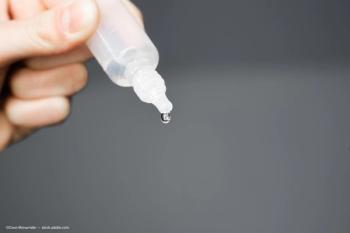
Drug delivery systems could improve poor adherence
Jonathan S. Myers, MD, reports that intraocular drug delivery systems could help solve the problem of poor adherence in patients taking glaucoma medications. Implanted in the eye, the systems would allow for glaucoma drugs to gradually dissolve or elute medication.
By Laird Harrison;Reviewed by Jonathan S. Myers, MD
Intraocular drug delivery systems could help solve the problem of poor adherence in patients taking glaucoma medications, according to Jonathan S. Myers, MD.
Implanted in the eye, intraocular drug delivery systems for glaucoma drugs gradually dissolve or elute medication, relieving the patient of a daily regimen that can be difficult psychologically and physically.
"Patients don't want to be reminded every day that they have a potentially blinding disease," said Dr. Myers, co-director, Glaucoma Service, Wills Eye Hospital, Philadelphia.
Dr. Myers described three devices now in clinical trials–the Bimatoprost SR (Allergan), the ENV515 (EnvisiaTherapeutics), and the iDose (Glaukos).
Studies confirm non-adherence
Studies have shown that most patients do not completely adhere to the regimens for their glaucoma prescriptions. In one study (Ophthalmology, 2009 Feb; 116(2):191-9), almost 45% of patients used their drops less than 75% of the time, even though they got free medication and knew that their adherence was monitored electronically.
Patients reported that they were taking a lot more medication than the monitoring indicated. And, their physicians had no idea how much their patients were taking.
"This shows the challenge," Dr. Myers told Ophthalmology Times. "We'd all agree it would be preferable if drug administration could be done for the patient."
Since the depots must be implanted and/or refilled via injection, the question rises whether they pose a risk of endophthalmitis.
Assuming yearly injections over 20 years and an endophthalmitis vision loss rate similar to that of anti-vascular endothelial growth factor (anti-VEGF) drugs, about 0.15% of patients would lose at least 2 lines of vision from endophthalmitis. By contrast, the risk of blindness from glaucoma over 20 years is 6.5%.
"The risk is very much justified versus the risk of going blind," Dr. Myers said. "It's not unreasonable to think about doing these injections."
Bimatoprost SR
The Bimatoprost SR is a biodegradable implant placed in the anterior chamber with a 28-gauge applicator. After sterile preparation and numbing the eye, the clinician slightly inserts the needle and presses an actuator button to launch a tiny pellet into the eye.
"The actual procedure itself is pretty minor from the patient's perceptive," said Dr. Myers.
The pellet falls into the anterior chamber angle, then shrinks as it dissolves.
In a phase I/II clinical trial (J Ophthalmol, 2017 Mar; 175:137-147), in 75 subjects the treatment rapidly lowered intraocular pressure (IOP) and maintained the reduction. Most patients received only 1 injection.
Through week 16, patients receiving a 6-μg dose experienced a 7.2 mm Hg reduction in IOP. Those receiving 10-μg dose had a 7.4 mm Hg reduction in IOP, those receiving 15-μg dose got a 8.1 mm Hg reduction, and those receiving 20-μg dose had a 9.5 mm Hg reduction. By comparison, patients treated with topical bimatoprost experienced a 8.4 mm Hg reduction in IOP.
"Most of the side effects had to do with the procedure itself and they weren't severe," said Dr. Myers.
Conjunctival hyperemia with onset later than 2 days after the injection procedure affected 17.3% of those receiving topical bimatoprost versus 6.7% of those receiving Bimatoprost SR.
Seventy-seven percent of patients said they would be extremely or very likely to repeat the procedure, and 83% said they would be extremely or very likely to recommend it.
"So from the patient's perceptive, it wasn't such a crazy thing to consider an injection every 3 to 4 months," said Dr. Myers.
ENV515
The Envisia ENV515 is a depot delivery of travoprost based on a new technology for nano- and microparticle formation. It relies on a proprietary injector and needle, similar to the ones for Bimatoprost SR.
In a phase IIa study, 5 subjects experienced similar reductions in IOP to those seen with timolol when treated after a washout period.
"The really impressive thing to me was not that these drugs worked, but that in this case, the single injection in these patients lasted 11 months," said Dr. Myers. "That's pretty close to once-a-year dosing. For a patient, that's a pretty good tradeoff for those who can be controlled with just one medication."
As with Bimatoprost SR, side effects related to injection procedure and were not severe, he said. The hyperemia scores were equivalent to those seen with a topical prostaglandin.
"With topical medication, you have to use much more because you're applying to the outside of the eye," said Dr. Myers. "So we hope with depot drugs, another benefit will be fewer side effects."
iDose
Rather than a biodegradable device, Glaukos, maker of the iStent microinvasive glaucoma surgery device, is testing a titanium implant (iDose) measuring 1.8 mm by 0.5 mm that embeds itself in the sclera with a barbed anchor and releases concentrated travoprost at a rate controlled by a membrane.
The implantation procedure is more involved than with the other two devices, said Dr. Myers.
"It's more than injecting a pellet of drug,” Dr. Myers said. “It requires viewing the angle with a gonio prism and the surgeon placing this in the right place."
Still, the treatment appears promising and more straightforward than many angle-based surgeries.
In a trial planned to last 3 years, 154 subjects were divided into 3 groups: a fast-eluting implant with placebo drops, a slow-eluting implant with placebo drops, and sham surgery with timolol drops twice a day.
In the first 9 months of data, which Glaukos shared with Dr. Myers, patients achieved a 8.3 mm Hg reduction in IOP with the fast-eluting device, 7.9 mm Hg reduction with the slow-eluting device and 7.6 mm Hg reduction with timolol drops.
Adverse events included increased IOP (2.6%), iritis (2.6%), decreased visual acuity of at least 2 lines (2.6%), dry eye (1.9%), inflammation (1.9%), eye pain (1.9%), conjunctivitis (1.3%), foreign body sensation (1.3%), and posterior vitreal detachment (1.3%).
Almost all the patients stayed in the trial for at least 3 months, but only about half remained after 9 months. "Still for that half, you get 9 months with a single procedure," Dr. Myers added.
"Multiple systems could come to market," Dr. Myers said. "All look like they have relatively good safety and efficacy."
Jonathan S. Myers, MD
p. (215-928-3197
This article was adapted from a presentation that Dr. Myers delivered at the Glaucoma Subspecialty Day held prior to the 2017 American Academy of Ophthalmology meeting. Dr. Myers is a consultant/speaker for Allergan and Glaukos, and he receives research grants from Allergan.
Newsletter
Don’t miss out—get Ophthalmology Times updates on the latest clinical advancements and expert interviews, straight to your inbox.














































.png)


